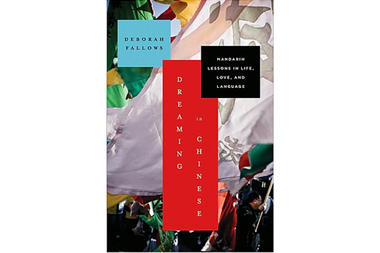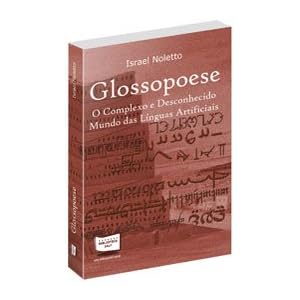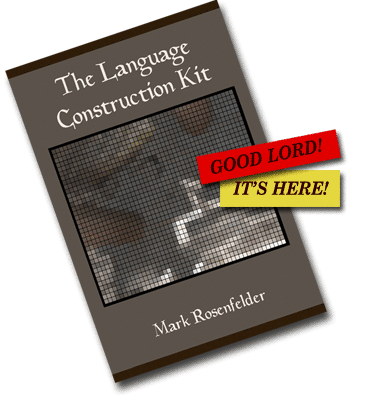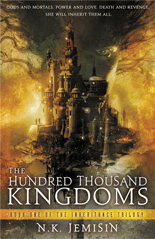Dreaming In Chinese: A Review

Dreaming in Chinese: Mandarin Lessons in Life, Love, and Language by Deborah Fallows is a highly enjoyable read for those interested in learning about the language spoken by over 1.2 billion people (depending on how you define "Chinese"). There are a number of favorable reviews of Fallows' book online (including here, here, and here). Personally, I disagree with the CS Monitor's review in wanting "a more cohesive narrative arc". I don’t think that was the point. I saw this as “a Sunday newspaper column” collection and enjoyed them for the taste of Chinese culture and language that they provided; a table full of dim sum, if you will.
So, what does Dreaming in Chinese have to offer the average conlanger? Many will no doubt already be familiar with Chinese, but Fallows provides a good cultural-context overview for artlangers to consider. One example is the "overuse" by Americans of "Please", "Thank you", and other politeness words and phrases being seen as superfluous in that it puts distance between two speakers. This is in the "When rude is polite" chapter introduced by the phrase Bú yào " Don't want, don't need". Sounds like Klingon, but for entirely different "cultural" reasons.
One thing that everyone seems to know about Chinese is its use of tones and its limited syllables. Fallows does a great job of highlighting this in her chapter entitled "Language play as a national sport" (introduced by the words Shī, shí, shî, shì "Lion, ten, to make, to be"). The author brings up Chao Yuen Ren who wrote a story entitled "The Lion-eating Poet in the Stone Den" composed of 92 characters, all of various tones of the syllable shi. Tones are used by a little over 41% of the languages in the World Atlas of Language Structures (WALS), whereas over at the Conlang Atlas (CALS), only a little over 24% use tones. This would appear to be a largely untapped feature for conlangs, although 30 conlangs at CALS do exhibit a (self-reported) "complex" tone system.
One conlang-specific item I was unaware of in relation to China was the extent to which Esperanto has been studied there. In her chapter entitled "A billion people; countless dialects", Fallows talks about Esperanto once being suggested as a common national language although it "was quickly abandoned as a far-out idea". The author's first family visit to China was as part of the World Esperanto Congress in Beijing in 1986.
Overall, Fallows does an excellent job of fulfilling her stated purpose with the book: to tell "the story of what I learned about the Chinese language, and what the language taught me about China." One is not going to learn all the idiosyncracies or fine grammatical points about Chinese, but if you’re looking for a user-friendly introduction to the fascinating language and culture of the Middle Kingdom, Dreaming in Chinese is highly recommended.
Through the Language Glass: A Conlanger’s Perspective
Through the Language Glass: Why the World Looks Different in Other Languages, the most recent book by Guy Deutscher, is a thought-provoking, highly-readable romp through some of the more unexpected realms of language. Deutscher is more than happy to take on with relish those ideas considered orthodox or “common sense” and to defend his own views, backing them up with facts and research. A number of very positive reviews of Through the Language Glass can be found online (such as here, here, and here, just to note a few), but what does the work have to offer conlangers? Being primarily an artlanger, I apologize ahead of time if this review strays too far in that direction. Deutscher’s book examines three main areas in-depth: color terms, grammatical gender, and spatial orientation. Let’s look at each of these in turn.
First, we examine color terminology. Deutscher examines how different languages split up the spectrum, and it turns out that my *blue* may not necessarily be your *blue*. In explaining the history of color terms, the author reaches back to W. E. Gladstone’s Studies on Homer and the Homeric Age, Volume 3, and its section entitled Homer’s Perception and Use of Colour and continues all the way up to the World Color Survey. The idea of slicing up the WCS-Munsell Color Chart or the CIE Color Space in novel ways to highlight the alien-ness or foreign-ness of a conlang’s speakers appeals to me. As Deutscher points out clearly, there are a number of interesting variations on the theme of how colors are designated in the world of natural languages. Even a language as familiar as Russian has "синий" and "голубой" whereas English simply has "blue". Granted, we English-speakers have shades of blue (light, dark, navy, baby, sky, etc.) and blue-related colors (turquoise, azure, indigo, etc.). Is purple a kind of blue? These are all concepts that can be played with in a conlang.
Next, let’s look at grammatical gender. Personally, I think this is a largely untapped field for conlangs to play in. Some of the African and Australian gender systems are very tempting to riff on. Deutscher talks about the “Bantu languages such as Swahili [which] have up to ten genders, and the Australian language Ngan’gityemerri is said to have fifteen different genders.” Of the 319 languages which specify use of grammatical gender in the Conlang Atlas of Language Structure database, over half (175 or 54.8%) use no gender at all. More interestingly, 84 conlangs use the familiar sex-based gender system and only 60 are non-sex-based. Another thing to consider is that it might be fun to determine how gender is assigned to words in one’s lexicon. One of my favorite stories related by Deutscher (in both Through the Language Glass as well as The Unfolding of Language) is how the Gurr-goni word "erriplen" (English "airplane") ended up in the vegetable gender category. It makes perfect sense when the history is known (or surmised), but, on first glance it makes no sense at all. Of course, if one is attempting to streamline or simplify language, gender is probably first on the list of things to excise. Alternatively, a conlang that attempts to be akin to natural languages would be more than likely to have grammatical gender. Why not have fun with it?
Finally, what about spatial orientation? This is the area that made the most impact on me. I really want to come up with a novel (or one that at least doesn’t have too many ANADEWisms) orientation system now. Deutscher provides several excellent alternatives to simple left-right-front-back. One is Guugu Yimithirr which uses an east-west-north-south system all the time. Another is Tzeltal (a Mayan language) which uses a downhill-uphill-across (in the direction of X). On the Marquesas Islands in French Polynesia, one finds mountainward-seaward-east-west. Depending on the geographical location of one’s conlang-speakers, I can see these or other systems being a lot of fun to create. Is there a specific location of historical/spiritual/geographical significance to your speakers? Orient towards that. This would also have some interesting connotations within a story as well (as well as lots of opportunity for misunderstandings… which could be a positive plot device).
These are just a few of the highlights in Deutscher’s new book. His The Unfolding of Language is one of my favorite narrative nonfiction books on language. (Arika Okrent‘s is, of course, another.) His new one is well worth the read, and has some great quotes, intriguing points, and enjoyable prose. Whether you buy it, check it out from your local library, or borrow it from a friend, make sure to put it on your conlang reading list.
Explorations in the Library
After the mind-numbing tedium of sorting out the situation shared in my last post, I felt I needed something more uplifting. And so…
Over the last couple months, I’ve had the opportunity (as part of my day job) to visit the libraries at Kent State University (KSU) and The Ohio State University (OSU). Having some free time available before or after my official duties were completed, I decided to visit the PM8001 to PM9021 areas of the Library of Congress Classifications hanging out on the open shelves. For those less-versed in bibliographical arcana, those are the areas dedicated to artificial, universal, picture, and secret languages. I was curious what would be represented in my favorite subject on the open stacks of the two universities.
KSU had only a couple shelves dedicated to the PM8001 to PM9021’s; however, it was not all dedicated to what one would expect. What I expected was a lot of Esperanto, which I got; however, they also had several more esoteric volumes sitting there waiting for the eager conlanger to pick them up. These included a facscimile copy of Francis Lodowyck’s Common Writing from 1647 (PM8008 .L59 1969).
One surprise at KSU was a little volume entitled Enterprises of great pith and moment : a proposal for a universal second language by Elmer Joseph Hankes (PM8008 .H34). Published in 1982, the subtitle of the work named this “universal second language” Em Sigh Ay or the “language called please or Polite Language”. The book is “dedicated to the promotion of politeness and consideration in all of our relationships with each other.” I did not have the time to see how this high-minded goal was carried out in detail. For those interested, the title of the work comes from Hamlet, Act III, Scene 1:
Thus conscience does make cowards of us all,
And thus the native hue of resolution
Is sicklied o’er with the pale cast of thought,
And enterprises of great pith and moment
With this regard their currents turn awry
And lose the name of action.
Yesterday’s visit to OSU turned up many more volumes residing in the latter PM’s on the open shelf. This is to be expected, as OSU is one of the major universities in the country. Even so, they fit on about one-and-a-half shelving units total. They had the requisite volumes on Esperanto, David Salo’s Gateway to Sindarin, and some other fairly-well-known languages. Some surprises, to me at least, were aUI: the language of space; for the first time represented and adapted to the needs of this planet by John W. Weilgart with illustrations by Elisabeth Söderberg (PM8008 .W4). This was published in 1968 by Cosmic Communication Company. Another surprise was The complete dictionary of Guosa language: 106,962 head words from traditional Nigerian and West African languages : a 20th century evolution by Alex Ekhaguosa Igbineweka (PM8368.Z5 I359 2007). It appears that Igbineweka also has a website with video on his proposed Nigerian and West African lingua franca. Finally, there was also A Moroccan Arabic Secret Language : the x…xinCa family by Nasser Berjaoui (PM9001 .B47 2007). I’m not quite sure if the language described by Berjaoui is a conlang or not, but it certainly is in the right LCC area. In any case, it was very interesting to see languages from Africa represented on the shelf.
While these titles were new to me, I have subsequently seen some of them listed in both Arika Okrent’s list and Rick Harrison’s comprehensive bibliography. Just goes to show, no matter how much you think you know about invented languages, there’s always more to learn.
Fiat lingua!
New Conlanging Book!
 Israel Noletto has published a new book examining the world of constructed languages entitled Glossopoese – O Complexo e Desconhecido Mundo das LÃnguas Artificiais. As you might guess from the title, the book is written in Portuguese, Noletto’s first language. He has graciously supplied The Conlanging Librarian with an English translation of the book’s description:
Israel Noletto has published a new book examining the world of constructed languages entitled Glossopoese – O Complexo e Desconhecido Mundo das LÃnguas Artificiais. As you might guess from the title, the book is written in Portuguese, Noletto’s first language. He has graciously supplied The Conlanging Librarian with an English translation of the book’s description:
Many have probably already seen, heard or read something about languages like Esperanto, Quenya and Sindarin. Maybe some have seen films or read pieces of literature full of exemplars of the artificial languages. Yet, when people hear anything related to this, they frequently react out of total surprise, and ask questions like: That language was invented by an individual, how so? Is it a mixture of other languages? Is it a code? In Glossopoesis – The Complex and Unknown World of the Artificial Languages, the author researches the available literature and the various communities throughout the world and the Internet. As a result, the answers to the forementioned questions have been found, and a new scientific perspective on the Glossopoesis has been developed.
When asked if he plans an English translation of Glossopoese, Noletto replied “I definitely plan on translating my book into English, although I don’t see it happening any time soon, since I’m already involved in a number of other conlanging related researches to make our secret vice more well-known and scientifically respected in my own language right now.” An extremely admirable goal! Glossopoese definitely has the potential to spread the word to the Portuguese-speaking world about the art and science of language creation. In the meantime, Noletto’s important new work should spur those English-speakers with an interest in conlanging to brush up on their Portuguese.
Israel Noletto is well-qualified to pen a book on conlanging. On January 26, 2009, he was the first person to host a “conlang event” in the Brazilian state of PiauÃ. Actually, this was his final essay defense for his degree in “‘Letras/Inglês’, a University course focused on the English Language and Literature.” (Click here for his posting in Portuguese.) It would also appear that conlanging runs in his family. (Click here for a rough English Google translation of that page.)
So, Parabéns! on publishing the book and Obrigado! for the efforts on behalf of conlanging. (Note: I’m hoping those mean “Congratulations!” and “Thank you!” respectively. I had to look them up online.)
Worlds Collide
 I had the oddest experience today. I work at a large metropolitan library and was walking down the hall today when a patron saw me and said, “Saluton! I was reading about you in a book today.” This particular patron was vaguely familiar, but I hadn’t really had the opportunity to speak with him for a couple years. Not since I worked in a different department. Well, my brain started spinning, and I finally asked, “Do you mean Arika Okrent’s In the Land of Invented Languages? He said, “Yeah. Can you say hello in your chipmunk language?” Unfortunately, I’ve been away from Drytok for a while, so I couldn’t oblige him…the shock of being asked to speak it out-of-the-blue notwithstanding. We talked for a while; I told him about Arika’s new book I heard she was working on, and I encouraged him to check out the posting at the Language Creation Society page of the actual LCC presentation of Drytok’s first public appearance. All in all, a great way to brighten up a Monday! 🙂
I had the oddest experience today. I work at a large metropolitan library and was walking down the hall today when a patron saw me and said, “Saluton! I was reading about you in a book today.” This particular patron was vaguely familiar, but I hadn’t really had the opportunity to speak with him for a couple years. Not since I worked in a different department. Well, my brain started spinning, and I finally asked, “Do you mean Arika Okrent’s In the Land of Invented Languages? He said, “Yeah. Can you say hello in your chipmunk language?” Unfortunately, I’ve been away from Drytok for a while, so I couldn’t oblige him…the shock of being asked to speak it out-of-the-blue notwithstanding. We talked for a while; I told him about Arika’s new book I heard she was working on, and I encouraged him to check out the posting at the Language Creation Society page of the actual LCC presentation of Drytok’s first public appearance. All in all, a great way to brighten up a Monday! 🙂
New Book by Guy Deutscher
One of my favorite books on language is Guy Deutscher’s The Unfolding of Language. It’s accessible, informative, and just a lot of fun to read. Well, I just discovered that he’ll be coming out with a new one on August 31 (That’s in 2 days!): Through the Language Glass. Here’s the product description from Amazon.com:
Linguistics has long shied away from claiming any link between a language and the culture of its speakers: too much simplistic (even bigoted) chatter about the romance of Italian and the goose-stepping orderliness of German has made serious thinkers wary of the entire subject. But now, acclaimed linguist Guy Deutscher has dared to reopen the issue. Can culture influence language—and vice versa? Can different languages lead their speakers to different thoughts? Could our experience of the world depend on whether our language has a word for “blue”?
Challenging the consensus that the fundaments of language are hard-wired in our genes and thus universal, Deutscher argues that the answer to all these questions is—yes. In thrilling fashion, he takes us from Homer to Darwin, from Yale to the Amazon, from how to name the rainbow to why Russian water—a “she”—becomes a “he” once you dip a tea bag into her, demonstrating that language does in fact reflect culture in ways that are anything but trivial. Audacious, delightful, and field-changing, Through the Language Glass is a classic of intellectual discovery.
Of course, I haven’t read it yet, but I’m looking forward to posting a review. There is an adaptation from an excerpt posted as an article online: “Does Your Language Shape How You Think?”. It’ll be interesting to see Deutscher’s take on the classic debate. Can’t wait.
New World-Building Resource!
I just began reading a book that appears to have much to offer in the way of world-building ideas: What If the Earth Had Two Moons? And Nine Other Thought-provoking Speculations on the Solar System by Neil F. Comins. I’ve just finished the first chapter and even there I’ve already found the following “thought-provoking” ideas:
And this is just the first chapter! Granted, there are a number of interesting web sites in which to get similar information (e.g., World Builders), but Comins’ book provides an easily-digestible way to get the creativity flowing. He also includes new names for the alternate Earths and their moons (or lack thereof) like Dimaan (“Earth”), Kuu (“Moon”), and Lluna (the 2nd captured moon in the first chapter). He also includes brief narratives introducing each new chapter’s concepts, like a Dimaanian Galileo Galilei getting arrested by the Dimaanian Inquisition in the first chapter.
Although not a conlanging resource per se, this book has the potential to serve as a jumping off point for those who want to lend the environment in which their conlangs are spoken a firm footing in (an alternate) reality. I’m already thinking of the implications of the two quotes I mentioned above.
Fiat Mundos!
(Note: That’s supposed to be “Let there be worlds!” in Latin. I’m open to corrections ;-))
Not Conlangs, but…
I just finished reading The Hundred Thousand Kingdoms by N.K. Jemisin. Although she states clearly on her web site that “I didn’t consult a linguist to make the languages internally consistent, and I’m aware that some of the patterns of pronunciation contradict each other”, she has included some interesting con-vocabulary.
Most notably, the word esui which is defined in the book as follows: “The Darren language has a word for the attraction one feels to danger: esui. It is esui that makes warriors charge into hopeless battles and die laughing. Esui is also what draws women to lovers who are bad for them — men who would make poor fathers, women of the enemy. The Senmite word that comes closest is ‘lust,’ if one includes the variations ‘bloodlust’ and ‘lust for life,’ though these do not adequately capture the layered nature of esui. It is glory, it is folly. It is everything not sensible, not rational, not safe at all — but without esui, there is no point in living.”
This is just one word, but it demonstrates nicely (from my perspective) the ability of invented words to convey new ideas not available in natlangs. To use a natlang example, it’s like trying to convey in English the meaning of Schadenfreude, but with a con-vocabulary the sky’s the limit.
Although not a conlanger, Jemisin does a nice job of incorporating the idea of language. Her gods (yes, gods) speak their own tongue. Knowing this language allows scriveners to manipulate reality. Different peoples in the hundred thousands kingdoms speak their own languages (although we don’t actually read any of them in dialogues).
On a completely different level, the book was an enjoyable read. The characters were interesting. The plot had plenty of twists. Overall, a thumbs-up. Just don’t go looking for a conlang.
LCK in Print!
 Mark Rosenfelder, aka Zompist, has provided one of the most helpful and comprehensive introductions to conlanging on his web site for “more than a decade”: The Language Construction Kit (LCK). Now, Mark goes one better and has created a print version of the LCK which is “four times larger” than its online counterpart. The book’s Table of Contents and an FAQ can be viewed here and is available for purchase at Amazon.com. (For a previous post on Zompist here at The Conlanging Librarian blog, click here.)
Mark Rosenfelder, aka Zompist, has provided one of the most helpful and comprehensive introductions to conlanging on his web site for “more than a decade”: The Language Construction Kit (LCK). Now, Mark goes one better and has created a print version of the LCK which is “four times larger” than its online counterpart. The book’s Table of Contents and an FAQ can be viewed here and is available for purchase at Amazon.com. (For a previous post on Zompist here at The Conlanging Librarian blog, click here.)
Limits of Language

Limits of Language by Mikael Parkvall of Stockholm University. The book is an entertaining collection of trivia, facts, and information on language, linguistics, and languages. The calendar is also an interesting collection of important dates for the field. Enjoy!


